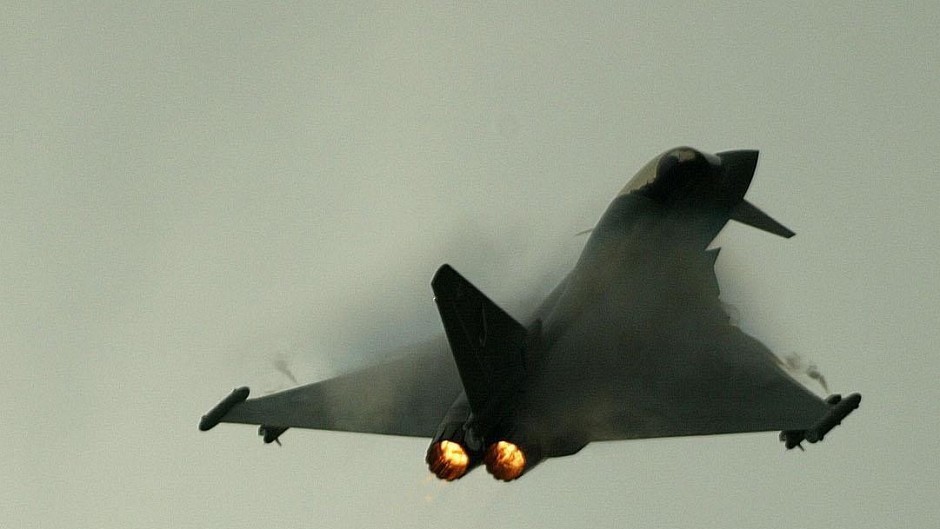RAF regulators have warned of the risk of a “catastrophic” crash between a Moray-based fighter jet and a passenger plane.
The fear was raised by the Military Aviation Authority (MAA) as it questioned the Ministry of Defence’s failure to fit anti-collision systems to the UK’s Typhoon fleet.
MAA director general Air Marshal Richard Garwood suggested that ministers risked repeating the mistakes which led to the deaths of three RAF Lossiemouth crew in the 2012 Tornado crash over the Moray Firth.
He said delays in developing the system created “unnecessary risk” and that the programme should be accelerated.
A damning report by the in-house regulator last year found that the failure to fit a collision warning system to the Tornado GR4s was a contributory factor in the 2012 tragedy, and recommended that the technology also be installed in the more advanced Typhoon aircraft.
Three Typhoon squadrons have since moved to RAF Lossiemouth.
The air marshal issued yesterday’s warning just weeks after an official investigation found that two Typhoons had to take evasive action after seeing a Jetstream 41 passenger plane on their radar about 15 miles south-east of Lossiemouth.
The new MAA report makes it clear that Defence Secretary Michael Fallon must have been told of the risk to society of not fitting Airborne Collision Avoidance Systems (ACAS).
The air marshal said: “The provision of an ACAS to Typhoon is an important issue for Defence.
“As I stated in the Moray Firth Tornado MAC (mid-air collision) service inquiry, in my view not fitting an ACAS to the Typhoon is an unsustainable position and I recommend that this is pursued with full haste, mindful of the well-documented failings over the fitment of an ACAS to Tornado GR4.”
He added: “In the worst case, which is judged improbable but catastrophic, a Typhoon colliding with CAT (commercial air traffic) could result in severe consequences for the MoD because of the likely substantial third party loss of life.
“The secretary of state will have been informed of the societal concern with regard Typhoon MAC by the chief of the air staff in accordance with MAA regulations.”
The air marshal added: “Ultimately, the Typhoon will be in service for many years and, if the MoD elects not to fit an ACAS, the decision will need to be well documented and the risk held at the highest levels of Defence.”
Angus Robertson, Moray MP and SNP defence spokesman, branded it a “hugely damning” report for the MoD.
“Twenty years after it was proven and recommended that these systems would save lives they remain to this day uninstalled,” he said.
“It is clear that the MoD with its cavalier approach to safety has learned no lessons as it has not even made the systems mandatory on new fast jets it acquires, while it drags its feet installing them on the ones they use already.
“The director general is right to say that there is unnecessary risk – which includes an unthinkable collision with a civilian airliner – and the MoD have known this for decades and have done far too little.”
The MAA’s inquiry into the 2012 Tornado crash found 17 factors contributed to the deaths of Flight Lieutenant Adam Sanders, Squadron Leader Samuel Bailey and Flight Lieutenant Hywel Poole, including the failure to install a warning system that was first identified by officials in 1990.
The MoD vowed to fit the £50million system to the Tornados – which are currently being used to bomb the ISIS terror group in Iraq – by the end of last year.
However, the plans were shelved again after tests found “issues that require resolution” before it can be rolled out.
Last year, Defence Minister Philip Dunne told parliament that analysis was under way on the potential to fit a collision warning system on Typhoon aircraft.
He added in July that “at this stage we are not far enough along in that process to be able to give clarity on either timetable or cost”.
An MoD spokesman said last night: “The department has welcomed the director general of the MAA’s report, and is acting upon its comments and recommendations.
“Air safety is at the core of all our aviation activity and we take very seriously our obligations to our people and the wider community to ensure that our activities are both as safe as reasonably practicable and comply with relevant policy and legislation.”
